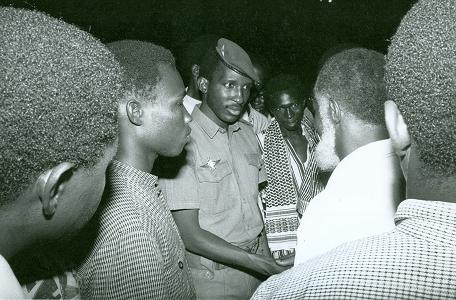A few weeks ago, I posted some thoughts and photos from the New Afrika Shrine nightclub in Lagos. One of those pictures featured a painting of Burkina Faso’s late president Capt. Thomas Sankara , which was hanging next to a rigger putting up a neon Red Bull sign on the wall. The irony here: Sankara loathed the notion of Africans importing stuff they admired in movies and Western pop culture (like Red Bull), and yet, here was Red Bull hanging next to Sankara. Sankara was a 37 year-old army captain when he died. He was killed in a coup organized by his second in command Capt.
Blaise Compaore, who is president of Burkina Faso to this day. In the four years Sankara was president, he made a long list of enemies in Ouagadougou. Though it should be said, many of those enemies were urban elites in Burkina Faso who didn’t like Sankara’s attacks on urban middle-class affluence in one of the world’s poorest country; it wasn’t because Sankara was a brutal tyrant in the mold of Charles Taylor or Robert Mugabe. Here’s an enthusiastic (if not subjective) account of four years of Sankara.
His assassination was the first big story I covered in Africa. I happened to have arrived in Ouagadougou about a month before Oct. 15, 1987. I took the above photo of Sankara about five days before he was killed. It was at the reception that concluded an anti-apartheid conference held in Ouagadougou. A bit of sidebar trivia: the man with the white beard whose hand Sankara is shaking is George Faisans. He was at the center of a 1985 controversy in Guadeloupe. A white schoolteacher had kicked a black student (kicking is an outrageous insult in the French West Indies, and is a bitter reminder of the colonial masters’ treatment of slaves). Faisans intervened, attacking and injuring the schoolteacher with a machete. He was sentenced to four years in jail (the schoolteacher was “disciplined”), where he immediately undertook a hunger strike.
Large street protests ensued in Point à Pitre calling for his liberation. He was transferred to a prison in Paris, but the cries from the streets of Guadeloupe were too loud to ignore. Faisans was released on July 24, 1985. Sensing a simpatico revolutionary ambiance in Burkina Faso, Faisans moved there soon after. I’m not sure if Faisans and Sankara had met prior to this picture in 1987. But Sankara seemed to know who Faisans was and his significance. I used to drink with Faisans at a bar in the center of town managed by a lovely Burkinabe rasta named Bawa Dakambary. But that’s another story.
May 27, 2009
Source : [http://marcowerman.wordpress.com/2009/->http://marcowerman.wordpress.com/2009/05/27/thomas-sankara-meets-george-faisans/]











